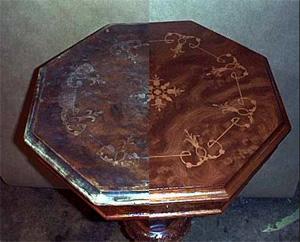Blushing and white spots on wood furniture can be caused by exposure to excessive moisture and humidity. These discolorations look like milky or cloudy spots, and can make an otherwise beautiful piece of furniture look dull and damaged. If this happens, you might initially think the entire piece must be refinished, but it is actually possible to correct the problem using one of several tested methods. Before choosing how to handle the situation, it’s important to understand what causes blushing and white spots to occur in the first place.
What is Blushing?
White clouds or a haze that appears on the surface of a piece of wood furniture is called “blush” or “blushing.” The look of blushing usually resembles a white cloud that seems to be suspended in the lacquer, varnish, or shellac that was originally applied to seal and protect the furniture. Usually, blushing occurs when wood furniture has been kept in a high-humidity area, when the furniture has been exposed to moisture from a liquid spill, or when the furniture has been placed outside for an extended period of time. Blushing can also occur when a spray finish is applied to the furniture in a humid or moist environment.
What are White Spots?
White spots are like blushing in that they cause a milky-looking spatter appearance on furniture. Similar to blushing, white spots are caused by excessive moisture. However, unlike blushing which looks like a white cloud inside of a wood piece’s finish, white spots are more speckled. They are typically caused by spills from a glass of liquid or from water that has been inadvertently splashed on furniture without being immediately dried with a cloth. Sometimes white spots are caused by a hot dish, a cup filled with liquid, or a plate of food that was placed directly on the wood surface. White spots can also result from a damp flower pot that that has been placed directly on the wood.
How can Blushing and White Spots be Safely Removed?
There are several methods that are commonly used to remove blushing and white spots. Typically, both problems can be removed using the same or similar tactics. All methods can be tried with minimal effort, but if none work to your satisfaction, the furniture can always be completely refinished by either you or a professional.
Method 1: Steel Wool and Linseed Oil
Use steel wool (number 0000) that has been dunked in linseed oil to buff the area of the furniture that has blushing or white spots, making sure to rub in the direction of the wood’s grain. Continue until the blushing and/or white spots are no longer visible. After wiping the wood dust away with a smooth rag, apply hard furniture wax to the area. The last step is to buff and polish the newly waxed area until it shines and matches the surrounding area.
Method 2: Denatured Alcohol
Denatured alcohol, which is a mild solvent, can be used to help remove blushing and white spots. To try this method, make sure the surface is completely dry, and then use a cloth that has been moistened with denatured alcohol to wipe the area. Remember to use light yet fast strokes, and do not rub the area (because this can cause permanent damage to the finish). This method can be repeated two or three times. When the blushing and/or white spots disappear, the area can then be waxed and polished to restore its original glossy finish.
Method 3: Rottenstone and Water
Mix rottenstone (which is a form of powdered stone) and water to form a paste. Using cheesecloth, rub the mixture over the affected area. Wipe the area until the blushing or white spots disappear, making sure to not over-rub, which can cause a depression in the wood. Finally, apply furniture wax and polish to the area and buff it until it shines.
Method 4: Refinish the Furniture
There is no need to live with blushing and white spots on your wood furniture. If you have tried one of the above methods for removing the milky spots and cloudy areas in your furniture’s finish and it did not yield your desired results, or if you do not feel comfortable attempting to fix the problem yourself, you may want to consider having the piece repaired or refinished by a professional.


